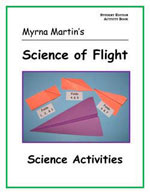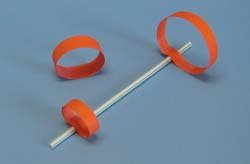Cool Science Experiments
Loop Airplanes
These cool science experiments about loop airplanes are easy to make and fun to fly. Kids have combined straws and increased the number of rings to make these paper airplanes fly the length of a football field!
Materials
- Straw (look for a long straw like the ones for 44oz drinks)
- Strips of heavy paper (index weight)
- Scissors
- Scotch tape
Directions
- Cut 2 strips of paper from heavy paper.
- One strip should be 1/2 inch
wide and 9 inches long.
- The second strip should be 1/2 inch wide and 7 inches long. Tape the ends together on the 9 inch strip of paper.
- Next,
tape the ends of the 7 inch strip of paper together.
- Place the straw
inside the first loop and tape it about inch from the end.
- Next, tape the smaller loop about 1 inch from the front of the straw making sure both loops are taped to the same side of the straw. This is very important because the planes will not fly as well if they do not sit up straight on the straw.
- If you have trouble taping the loops to the straw you can also just overlap the 9 inch strip 1 inch and tape the ends together so that a straw can slip in between the overlapped edges. Repeat these steps with the strip that is 7 inches long.
Flying the airplane
- Place your pointer finger over the back end of straw after
getting the loops securely fastened to your loop airplane.
- The back end
of the airplane is where the largest loop is located. Hold the straw
between your thumb and another finger.
- Push your finger forward with a quick motion to make your plane fly.
- If your loop airplane flies about 20 or 30 feet it is built
correctly.
- If it doesn't fly that far try moving the straws closer together. Then try moving the loops further apart.
- Keep trying until your plane flies correctly.
Try these other cool science experiments with your loop airplane. Try making the loops larger to see if they will fly futher. Try making the loops thinner or wider to see if your airplane will fly further. Try putting 2 or 3 straws taped together with additional loops to see how far you can make a loop airplane fly.


Click for More Information and to Order
Science behind the experiment
In these cool science experiments four forces are acting on loop airplanes as they fly through the air. The four forces are gravity, lift, thrust and drag. The force of gravity is always pulling airplanes toward the Earth.
The lift, provided by the loops on this airplane, provide the lift that keeps it in the air. The thrust is provided by your finger as you push the straw at the back of the loop airplane. The drag is the resistance of your airplane to fly through the air.
More Links to Science Experiments
Earth Science Experiments, Floating Eggs Fresh eggs sink in fresh water, see if you can get them to float in this fun science experiment.
Easy Science Experiment, Tin Foil Boats How many pennies do you think are the maximum you could put in a tin foil boat? Try this fun experiment and find out.
Elementary Science Experiments, Penny Drop In this fun science experiment you will see how many drops of water you can put on a penny without it overflowing.
Fun Science Experiment, Marble Powered Race Cars Create a ramp, a paper car and see how far you can make the car travel powered only by a marble!
Easy Science Experiments Lots of easy experiments for kids of all ages.
Kids Fun Science The links on this page include information science activities, science experiments, plate tectonics, the rock cycle and much more
Cool Science Experiments, Loop Airplanes Find out how to build a loop airplane with a straw and two strips of paper.
KIDS FUN Science Bookstore
Check out Myrna Martin's award winning textbooks, e-books, videos and rock sets. The Kids Fun Science Bookstore covers a wide range of earth science topics. Click here to browse.











